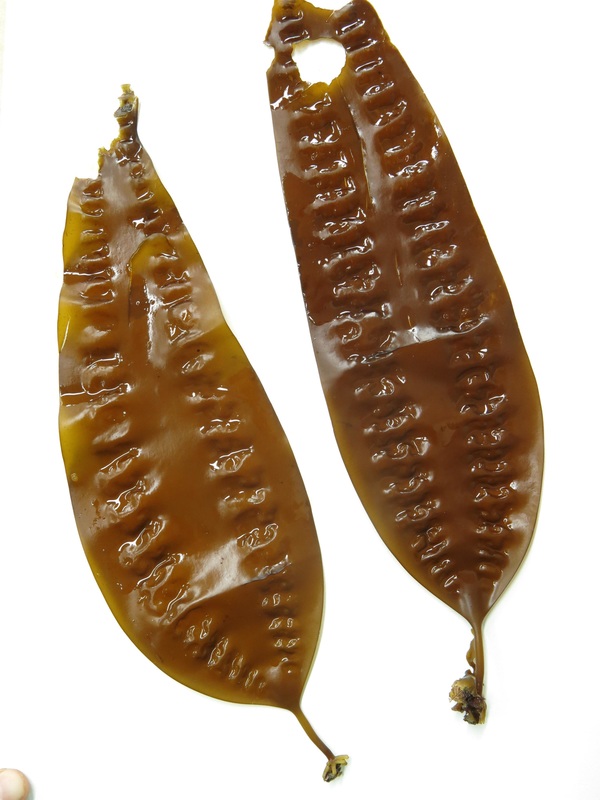Sugar kelp, sugar wrack kelp • Saccharina latissima, formerly Laminaria saccharina
Right: young sugar kelp specimens; note the bullations. Photo by Jenn Burt. Left: Specimen collection number SCL 15379 in the UBC Herbarium Algae Database. Search the collection number in the database for more information on this specimen, or search the species for further occurrences. Images courtesy of Sandra Lindstrom.
Identification
This perennial brown seaweed is light to medium brown, with a single blade that reaches 3.5 cm long and lacks a midrib. The blade has a ruffled, undulating appearance particularly along the edges, and often has two rows of bullations near the base which create a puckered or blistered texture. While the blade is not divided, it may be tattered near the tip. The cylindrical stipe reaches 50 cm long, while the holdfast is composed of many finely-branched haptera.
Habitat & Range
Sugar kelp grows on rock in the low intertidal and shallow subtidal, along protected to semi-protected shorelines. The blade grows in spring and dies back in fall/winter. This species is found on both sides of the Pacific Ocean — from Korea and Japan north to the Bering Sea, Aleutian Islands, and Arctic Ocean, and from Alaska south to California. It is also found in the North Atlantic and the North Sea.
Similar Species
Split kelp (Saccharina groenlandica) has a similarly puckered texture and can reach a similar size (2 m long). It is often (but not always) split lengthwise, it tends to be less ruffled in apperance, and its cylindrical stipe flattens visibly near the base of the blade. Despite these differences, the most definitive way to distinguish the two species is by the presence or absence of relatively large (but still microscopic) empty intercellular spaces called mucilage ducts inside the stipe: these ducts are present in split kelp (starting in the second year of growth), but not sugar kelp.
Human Uses
Sugar kelp is eaten in casseroles and oriental dishes. It is rich in iodine, protein, calcium, and has notably high amounts of vitamin C. Click here for some recipe ideas and preparation tips (note: sugar kelp is referred to by its former name Laminaria saccharina in this document).
Intriguing Info
This species is consumed by sea urchins and other invertebrate herbivores, such as the dusky turban snail (Tegula pulligo)
iNaturalist
https://www.inaturalist.org/taxa/130231-Saccharina-latissima
This perennial brown seaweed is light to medium brown, with a single blade that reaches 3.5 cm long and lacks a midrib. The blade has a ruffled, undulating appearance particularly along the edges, and often has two rows of bullations near the base which create a puckered or blistered texture. While the blade is not divided, it may be tattered near the tip. The cylindrical stipe reaches 50 cm long, while the holdfast is composed of many finely-branched haptera.
Habitat & Range
Sugar kelp grows on rock in the low intertidal and shallow subtidal, along protected to semi-protected shorelines. The blade grows in spring and dies back in fall/winter. This species is found on both sides of the Pacific Ocean — from Korea and Japan north to the Bering Sea, Aleutian Islands, and Arctic Ocean, and from Alaska south to California. It is also found in the North Atlantic and the North Sea.
Similar Species
Split kelp (Saccharina groenlandica) has a similarly puckered texture and can reach a similar size (2 m long). It is often (but not always) split lengthwise, it tends to be less ruffled in apperance, and its cylindrical stipe flattens visibly near the base of the blade. Despite these differences, the most definitive way to distinguish the two species is by the presence or absence of relatively large (but still microscopic) empty intercellular spaces called mucilage ducts inside the stipe: these ducts are present in split kelp (starting in the second year of growth), but not sugar kelp.
Human Uses
Sugar kelp is eaten in casseroles and oriental dishes. It is rich in iodine, protein, calcium, and has notably high amounts of vitamin C. Click here for some recipe ideas and preparation tips (note: sugar kelp is referred to by its former name Laminaria saccharina in this document).
Intriguing Info
This species is consumed by sea urchins and other invertebrate herbivores, such as the dusky turban snail (Tegula pulligo)
iNaturalist
https://www.inaturalist.org/taxa/130231-Saccharina-latissima
References
Lamb, A., and Hanby, B. (2005). Marine Life of the Pacific Northwest [electronic version]. Madeira Park, BC: Harbour Publishing.
Lindberg, M. and Lindstrom, S. (2010). Saccharina latissima Sugar Kelp. Seaweeds of Alaska. Accessed 11/04/2016.
O'Clair, R. and Lindstrom, S. Saccharina latissima (Linnaeus) C.E. Lane, C. Mayes, Druehl, et G.W. Saunders. In Klinkenberg, Brian. (Ed.). E-Flora BC: Electronic Atlas of the Plants of British Columbia. Lab for Advanced Spatial Analysis, Department of Geography, University of British Columbia, Vancouver. Accessed 11/04/2015.
Authors and editors of page
Kelly Fretwell (2016).
Lamb, A., and Hanby, B. (2005). Marine Life of the Pacific Northwest [electronic version]. Madeira Park, BC: Harbour Publishing.
Lindberg, M. and Lindstrom, S. (2010). Saccharina latissima Sugar Kelp. Seaweeds of Alaska. Accessed 11/04/2016.
O'Clair, R. and Lindstrom, S. Saccharina latissima (Linnaeus) C.E. Lane, C. Mayes, Druehl, et G.W. Saunders. In Klinkenberg, Brian. (Ed.). E-Flora BC: Electronic Atlas of the Plants of British Columbia. Lab for Advanced Spatial Analysis, Department of Geography, University of British Columbia, Vancouver. Accessed 11/04/2015.
Authors and editors of page
Kelly Fretwell (2016).






